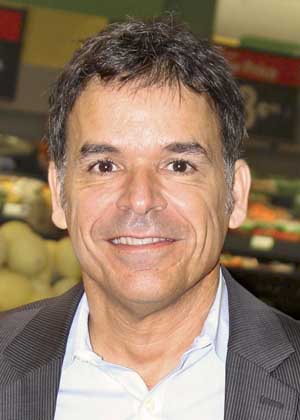
Apples on display at a Yakima, Washington, Wal-Mart. (TJ Mullinax/Good Fruit Grower)
Illnesses caused by foodborne pathogens are becoming much easier to track and investigate, and new science — whole genome sequencing — is enabling outbreaks to be traced to the source of the investigation.

Frank Yiannas
That means apple growers and packers need to up their game, according to Frank Yiannas, vice president of food safety and health for Wal-Mart.
“What you did for food safety last year is no longer good enough, and you’re going to have to do something different this year and next year,” Yiannas told some 300 industry members at the annual meeting of the U.S. Apple Association in Chicago.
Today’s supermarkets have tens of thousands of food products, and there will be new products derived from apples that will introduce new risks over the next 20 years, he said. “This concept of history of safe use, don’t let that lull you into complacency,” he said.
Yiannas offered a few tips to help ensure growers and packers are doing all they can to prevent an outbreak:
—Avoid complacency.
“Complacency is overconfidence and poor metrics,” he said. Talking to companies that have had outbreaks, Yiannas said he’s learned overconfidence plays a role — companies hadn’t had a problem, so they didn’t think they could have a problem. “And they were all using poor metrics to measure food safety,” he said.
—Ask questions and question assumptions.
—Manage real, regulatory and perceived risk. “If you aren’t an expert on true, public health risk, get experts,” he said.
—Also, regulations don’t always align with risk. “Don’t assume those two are the same all of the time,” Yiannas said. “There are some things I think you need to be doing to manage food safety risk with apples that FSMA won’t require you to do.”
—Prevention costs less than an outbreak. For the apple industry, that means focusing on the site where apples are packed and washed to make sure packing houses are designed with food safety in mind — that contamination is controlled and not spread — and that microbial evaluations are completed. “You can’t tell just by looking at it,” he said.
“The things you have to do are meaningful, and they can be done with low cost structures and still allow you to be profitable and have a healthy business.”
—Create a food safety culture, not a program. “Culture is about the shared values and beliefs. It persists through time,” he said. “It’s the soft stuff that’s the hard stuff, because all of food safety is about people.”
“Food safety culture is a choice,” he said.
Yiannas noted that, during an outbreak, retailers suffer the shortest amount of time, while the country of origin suffers the longest. “The apple industry wins and loses together,” he said. •
– by Shannon Dininny






I think the growers and packers are doing an excellent job of putting a safe product on the market. Mr Yiannas spoke in terms of a threat to the industry, yet offered no real steps to solve the perceived issue, just a generalization of his ideas.
The real issue with foodborne pathogens starts in his own stores. The fruit is exposed to public handling and what is on those hands, gets transferred to the fruit.
That can affect all of us, but it certainly is not the fault of the grower or packer. He should look at his own business first, and consider what they are doing to protect the public.
The sentiment may very well be true that “. . . growers and packers are doing an excellent job of putting safe product on the market.” However, it has the potential of lulling the growers and packers into complacency as Mr. Yiannas puts it. I do not see any exemption of Mr. Yiannas’ stores from the obligation of ensuring safe food at the stores in his article. What I see and support is the call to all along the supply chain to have the right understanding and commitment of protecting consumers from foodborne pathogens and other hazards. This is a chain-long responsibility.